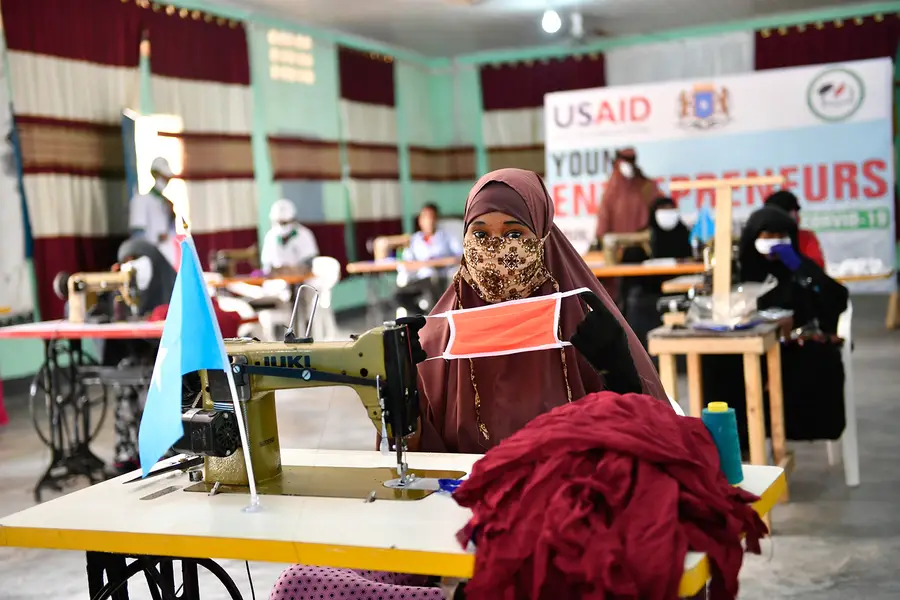
Youth in Somalia work to create non-medical grade protective face coverings and gloves to help slow the spread of COVID-19, thanks to training and support from USAID. Photo by Yussuf Ali/USAID Somalia GEEL Project.
It’s been four months since COVID-19 was declared a pandemic, and doomsday predictions of its effect on the African continent have not yet materialized despite some countries in the global North continuing to struggle with their responses.
There are currently about 600,000 reported coronavirus cases in Sub-Saharan Africa (SSA), compared to more than five million in the European Union (EU), the United States, and Canada. Mortality is also lower, with SSA’s reported death toll at less than 10,000 in contrast to about 330,000. We are seeing these differences even though SSA’s population of about one billion people is higher than the joint population of the EU, U.S. and Canada.
This begs the questions: Why are reported cases and deaths in SSA significantly lower than more developed regions with stronger health systems? And what should be the attitude going forward as governments in SSA begin considering guidelines for relaxing restrictions?
One theory that has been suggested to explain the lower reported cases and deaths in SSA is that the virus does not transmit as easily in Africa’s tropical climate. But there is currently no scientific consensus that the virus has less virulence or lower transmissibility in warmer climates. In addition, the ongoing summer uptick in cases in the U.S. and Brazil makes this idea less plausible.
Another potential explanation is that since many SSA countries quickly implemented a number of public health measures like fever checks and self-isolation at borders, they may have detected enough imported cases early on to stem further spread. However, these screenings would only detect symptomatic cases at the time of travel. Further into the outbreak, continued actions taken by governments across SSA such as restrictions on international flights and large gatherings as well as targeted lockdowns could have had a great impact in curtailing the spread of the pandemic.
It is also possible that there is vast underreporting due to the relatively low testing capacity across SSA countries. Hence, there could be ongoing widespread community transmission since the limited testing available is focused on symptomatic cases that present to health authorities and their traceable contacts. Furthermore, informal health sector providers like patent medicine vendors account for as much as 50 percent of health care utilization in countries such as Nigeria, Kenya, and Uganda, making it easy for those with mild symptoms to access medications such as antibiotics without being tested for COVID-19. Such cases would not be accounted for in official statistics making it likely that reported numbers do not accurately reflect the existing burden.
None of these theories fully explain why reported cases and deaths in SSA are comparatively lower. Hence, countries in SSA must avoid becoming complacent and stay vigilant to prevent the kind of escalation we have seen unfold across Asia, Europe, and now the U.S. and Brazil.
To their credit, many governments in SSA have instituted important actions to combat COVID-19, including establishing specialized COVID-19 taskforces, travel restrictions, the wearing of masks, and social distancing measures. Almost all countries have implemented closure of educational institutions and limited public gatherings. About 76 percent of SSA countries have instituted full border closures while others have applied specific entry and exit restrictions. The African Centers for Disease Control and Prevention (Africa CDC), which was established in 2016, has also led a notable response to the pandemic, including creating an Africa task force led by member countries’ technical experts, providing a platform for cross-country learning and procurement of essential medical supplies, and training frontline health workers in infection prevention and control.
As SSA countries begin to ease restrictions, maintaining vigilance will require effective communication to ensure compliance with social distancing and other longer-term public health guidance. For example, lessons learned from the Ebola response suggest that engaging and leveraging the influence of religious, traditional and political leaders to communicate the importance of complying with public health guidance could be beneficial. There has been mixed support thus far from religious leaders in some countries over government restrictions on religious gatherings. Engaging these leaders could help refute false narratives and prevent apathy or resistance to public health instructions.
Another key measure is to improve testing and surveillance capacity to prevent or reduce community transmission and obtain a better picture of the pandemic. The work of the Africa CDC through the Partnership to Accelerate COVID-19 Testing (PACT) initiative rolled out in early June is a welcome step to address the scaling up of testing across countries. The initiative aims to increase testing capacity from 2,000 tests per million across the continent as of early June to 16,000 tests per million by the end of 2020.
Ongoing coordination of the response across the continent must also be complemented by individual country context-driven approaches based on the best available evidence. For example, there is now widespread recognition that total lockdowns as implemented in countries like UK, Spain and Italy are impractical in developing countries, many of which have a large informal sector that rely on daily wages for survival. Hence, measures such as lockdowns or border closures should be tailored to country situations and based on best available evidence rather than political expediency.
For now, SSA appears to be faring better than the global North in terms of reported coronavirus cases and death toll. However, the numbers of cases and deaths reported may not be reflecting the reality on the ground. Given the limited health systems capacity of many countries in the region, leaders in SSA must continue to proceed with vigilance and sober awareness that COVID-19 escalations as seen in other regions are still possible.

